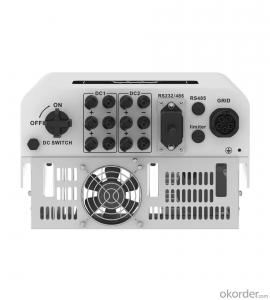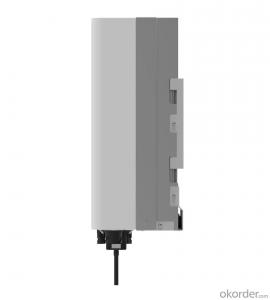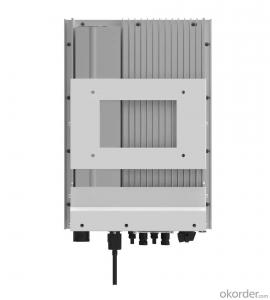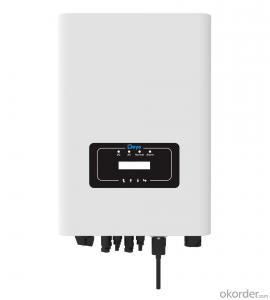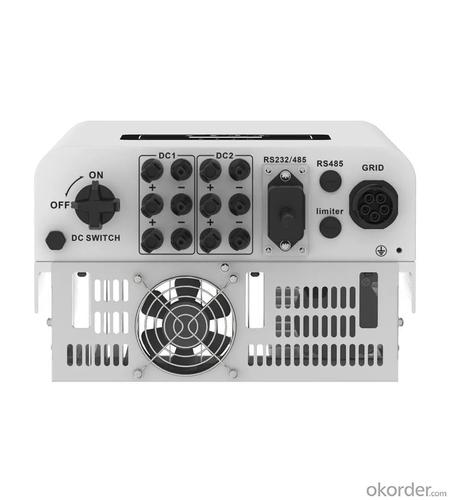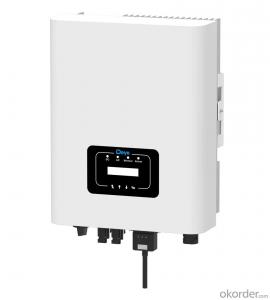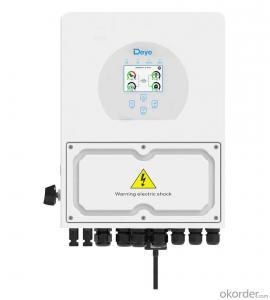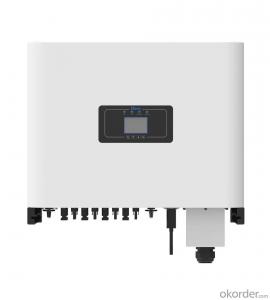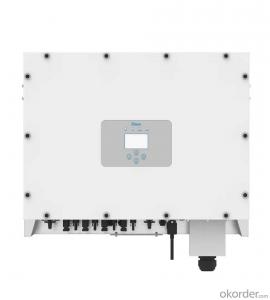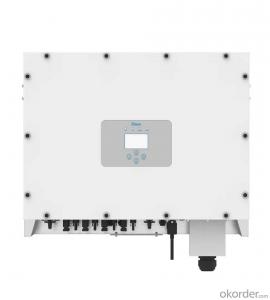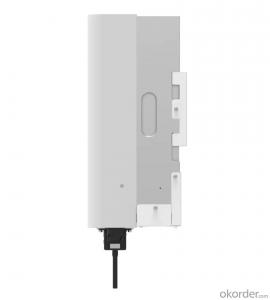3500 Watt Solar Inverter - Sun-10/12/15k-G03-LV | 10-15kW | Three Phase | 2 MPPT | Low Voltage | 127/220VAC
- Loading Port:
- Ningbo
- Payment Terms:
- TT OR LC
- Min Order Qty:
- 100 pc
- Supply Capability:
- 5000 pc/month
OKorder Service Pledge
OKorder Financial Service
You Might Also Like
Specification
| Technical Data | |||||
| Model | SUN-10K-G03-LV | SUN-12K-G02-LV | SUN-15K-G02-LV | ||
| Input Side | |||||
| Max. DC Input Power (kW) | 13 | 15.6 | 19.5 | ||
| Max. DC Input Voltage (V) | 800 | ||||
| Start-up DC Input Voltage (V) | 250 | ||||
| MPPT Operating Range (V) | 200~700 | ||||
| Max. DC Input Current (A) | 32+32 | ||||
| Max. Short Circuit Current (A) | 48+48 | ||||
| Number of MPPT / Strings per MPPT | 2/2 | ||||
| Output Side | |||||
| Rated Output Power (kW) | 10 | 12 | 15 | ||
| Max. Active Power (kW) | 11 | 13.2 | 16.5 | ||
| Nominal Output Voltage / Range (V) | 3L/N/PE 127/0.85Un-1.1Un,220 /0.85Un-1.1Un (this may vary with grid standards) | ||||
| Rated Grid Frequency (Hz) | 60 / 50 (Optional) | ||||
| Operating Phase | Three phase | ||||
| Rated AC Grid Output Current (A) | 26.2 | 31.5 | 39.4 | ||
| Max. AC Output Current (A) | 28.9 | 34.6 | 43.3 | ||
| Output Power Factor | 0.8 leading to 0.8 lagging | ||||
| Grid Current THD | <3% | ||||
| DC Injection Current (mA) | <0.5% | ||||
| Grid Frequency Range | 57~62 | ||||
| Efficiency | |||||
| Max. Efficiency | 98.6% | ||||
| Euro Efficiency | 98% | ||||
| MPPT Efficiency | >99% | ||||
| Protection | |||||
| DC Reverse-Polarity Protection | Yes | ||||
| AC Short Circuit Protection | Yes | ||||
| AC Output Overcurrent Protection | Yes | ||||
| Output Overvoltage Protection | Yes | ||||
| Insulation Resistance Protection | Yes | ||||
| Ground Fault Monitoring | Yes | ||||
| Anti-islanding Protection | Yes | ||||
| Temperature Protection | Yes | ||||
| Integrated DC Switch | Yes | ||||
| Remote software upload | Yes | ||||
| Remote change of operating parameters | Yes | ||||
| Surge protection | DC Type II / AC Type II | ||||
| General Data | |||||
| Size (mm) | 330W×508H×206D | ||||
| Weight (kg) | 20.8 | ||||
| Topology | Transformerless | ||||
| Internal Consumption | <1W (Night) | ||||
| Running Temperature | -25~65℃, >45℃ derating | ||||
| Ingress Protection | IP65 | ||||
| Noise Emission (Typical) | <45 dB | ||||
| Cooling Concept | Smart cooling | ||||
| Max. Operating Altitude Without Derating | 2000m | ||||
| Warranty | 5 years | ||||
| Grid Connection Standard | CEI 0-21, VDE-AR-N 4105, NRS 097, IEC 62116, IEC 61727, G99, G98, VDE 0126-1-1, RD 1699, C10-11 | ||||
| Operating Surroundings Humidity | 0-100% | ||||
| Safety EMC / Standard | IEC/EN 61000-6-1/2/3/4, IEC/EN 62109-1, IEC/EN 62109-2 | ||||
| Features | |||||
| DC Connection AC Connection Display Interface | MC-4 mateable | ||||
| AC Connection | IP65 rated plug | ||||
| Display | LCD1602 | ||||
| Interface | RS485/RS232/Wifi/LAN | ||||
27/220Vac and 60Hz, three phase system
2 MPP tracker, Max. efficiency up to 98.6%
Zero export application, VSG application
String intelligent monitoring (optional)
Wide output voltage range
Anti-PID function (Optional)
This series inverter is specially designed for 127/220Vac three-phase system, especially suits for South American areas. With compactness design, easy to install and operate. It supports wide AC output voltage to adapt to poor grid, extending the inverter working hours.
- Q: What are the safety measures to consider when installing a solar inverter?
- When installing a solar inverter, several safety measures should be considered. Firstly, it is important to ensure that the installation is performed by a qualified and certified professional to minimize the risk of accidents. It is crucial to follow the manufacturer's guidelines and recommendations during the installation process. Additionally, it is essential to disconnect the solar inverter from the power source before starting any installation or maintenance work to prevent electrocution. Proper grounding and wiring techniques should be followed to reduce the risk of electric shock or fire hazards. Adequate ventilation and temperature control should be provided to prevent overheating of the inverter. Regular inspections and maintenance checks should be conducted to ensure the inverter's safe and efficient operation. Overall, prioritizing safety measures during the installation process is crucial to protect both the installer and the system's end-users.
- Q: How does a solar inverter handle fluctuations in solar panel output due to temperature changes?
- A solar inverter handles fluctuations in solar panel output due to temperature changes by employing a maximum power point tracking (MPPT) algorithm. This algorithm continuously adjusts the operating voltage and current of the inverter to ensure that it operates at the maximum power point of the solar panels, despite the temperature changes. By dynamically adapting to the varying output of the panels, the inverter optimizes the energy conversion process and allows for efficient utilization of the available solar energy.
- Q: What is the role of a solar inverter in preventing islanding?
- The role of a solar inverter in preventing islanding is to continuously monitor the electrical grid and quickly disconnect from it if it detects any abnormalities or disruptions. This prevents the solar inverter from operating in an isolated or "islanded" mode, which could pose safety risks to utility workers and damage electrical equipment. By promptly disconnecting from the grid during such events, the solar inverter helps maintain the stability and integrity of the overall electrical system.
- Q: Can a solar inverter be repaired or replaced if it malfunctions?
- Yes, a solar inverter can be repaired or replaced if it malfunctions. In many cases, minor issues can be fixed through repairs, such as replacing faulty components or updating firmware. However, if the inverter is extensively damaged or beyond repair, it may need to be replaced with a new one. Ultimately, the course of action will depend on the severity of the malfunction and the expertise of the technician assessing the situation.
- Q: Can a solar inverter be used with a net metering system?
- Yes, a solar inverter can be used with a net metering system. In fact, a solar inverter is a crucial component of a net metering system. It helps convert the direct current (DC) electricity produced by the solar panels into alternating current (AC) electricity that can be used to power homes or businesses. The excess electricity generated by the solar panels is then fed back into the grid through the net meter, allowing consumers to receive credits or compensation for the surplus energy they produce.
- Q: Can a solar inverter be installed indoors?
- Yes, a solar inverter can be installed indoors.
- Q: Can a solar inverter be used for both grid-tied and off-grid systems?
- Yes, a solar inverter can be used for both grid-tied and off-grid systems. However, it is important to note that different types of inverters are designed specifically for each system. Grid-tied inverters are used to convert the DC power generated by solar panels into AC power to feed into the grid, while off-grid inverters are designed to convert DC power from solar panels into AC power for use in standalone systems. So, while the same physical inverter may not be suitable for both applications, there are inverters available for each system type.
- Q: How does a solar inverter handle voltage fluctuations?
- A solar inverter handles voltage fluctuations by constantly monitoring the input voltage from the solar panels and adjusting its output voltage accordingly. It maintains a stable output voltage even when there are fluctuations in the input voltage, ensuring that the electricity generated by the solar panels is suitable for use in the electrical grid or for powering appliances.
- Q: What is the role of a power factor controller in a solar inverter?
- The role of a power factor controller in a solar inverter is to regulate and maintain the power factor of the inverter's output. It ensures that the inverter's output power is in phase with the grid voltage, maximizing the efficiency of power transfer and reducing reactive power losses. By improving the power factor, the power factor controller helps to ensure stable and reliable operation of the solar inverter while meeting grid requirements and minimizing energy wastage.
- Q: How do you choose the right size of solar inverter for a system?
- When choosing the right size of solar inverter for a system, it is important to consider the total capacity of the solar panels and the expected power output. The inverter should have a capacity that matches or slightly exceeds the maximum power output of the panels to ensure optimal efficiency. Additional factors such as the type of grid connection and any future expansion plans should also be taken into account. Consulting with a professional solar installer or conducting a thorough system assessment can help determine the appropriate size of the inverter for a given solar system.
Send your message to us
3500 Watt Solar Inverter - Sun-10/12/15k-G03-LV | 10-15kW | Three Phase | 2 MPPT | Low Voltage | 127/220VAC
- Loading Port:
- Ningbo
- Payment Terms:
- TT OR LC
- Min Order Qty:
- 100 pc
- Supply Capability:
- 5000 pc/month
OKorder Service Pledge
OKorder Financial Service
Similar products
Hot products
Hot Searches
Related keywords
